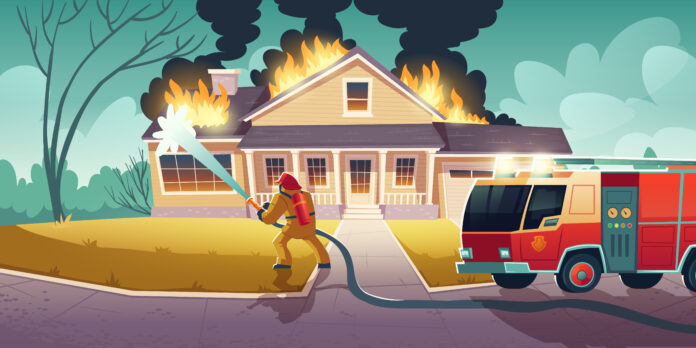It’s not every day that a small community like Muncy and nearby Williamsport sees multiple fires erupt almost simultaneously. Yet, on Tuesday morning, firefighters across Lycoming County found themselves racing from one scene to the next, proof that fires can strike in unexpected places, and sometimes all at once.
A Morning Call: Fire at Kepner Farm Supply
Shortly after 9 a.m., emergency sirens cut through the calm of Muncy Creek Township. Volunteer fire crews rushed toward Kepner Farm Supply on Maple Lane, where thick smoke was already pouring from the top of a three-story soybean dryer.
At first glance, it looked like a disaster was unfolding. “It looked a lot worse than it was,” admitted Muncy Area Fire Chief Scott Delany. To anyone driving by, the towering silo shaped structure belching smoke might have seemed on the verge of collapse.
Fortunately, the fire was contained quickly. Firefighters needed less than 200 gallons of water far less than what a typical house fire consumes. By mid-morning, the situation was under control. There were no injuries, and the damage appeared minimal. Still, the cause remains unknown, leaving both workers and neighbors with lingering questions.
If you’ve ever smelled smoke while working on a farm or even just passing by, you know how fast the heart races. Agricultural equipment like dryers and silos often runs nonstop, and even a small malfunction can turn dangerous in seconds.
A Scare at Frito-Lay: The Fryer that Fought Back
Almost at the exact same time, another call came in—this time from Williamsport. Inside the Frito-Lay plant on Reach Road, a “flash fire” erupted in one of the massive fryers used for producing snacks.
But here’s the twist: the fryer had its own built-in fire suppression system, which did its job perfectly. By the time city firefighters arrived, the flames were already out. No injuries, no downtime, and no further risk.
This incident may sound minor, but it highlights something crucial. Industrial kitchens and factories often invest in automatic suppression systems—and Tuesday showed why they’re worth every penny. If you’ve ever worked in food service, you know how fast oil fires can spread. Without that system, things could’ve ended very differently.
An Afternoon Blaze: Van Fire at McDonald’s
Just when it seemed like things might settle down, another fire broke out later that afternoon. Around 1:45 p.m., city and Old Lycoming Township firefighters were dispatched again—this time to the McDonald’s parking lot on Lycoming Creek Road.
A cargo van parked outside had flames shooting from its engine compartment. Before long, the fire spread into the cab, leaving the vehicle moderately damaged. Once again, firefighters acted swiftly and extinguished the blaze before it could threaten nearby cars or the restaurant itself.
Officials later confirmed nothing suspicious was involved. Like many vehicle fires, this one likely stemmed from a mechanical or electrical fault—something any driver could face. And while no one was injured, it’s a sobering reminder: vehicles are just as vulnerable to fire as homes and workplaces.
What Do These Fires Teach Us?
When you step back and look at the day as a whole, three separate fire incidents unfolded within just a few hours one on a farm, one in a factory, and one in a vehicle. None caused serious injuries, and damage was limited. But imagine if crews had been delayed. Imagine if systems hadn’t worked as designed.
So, what can we learn from these fires?
-
Preparedness saves lives. Volunteer fire companies responded quickly, proving yet again how critical they are to smaller communities.
-
Technology matters. The suppression system at Frito-Lay did exactly what it was built for. Businesses and homeowners alike should see that as proof that fire alarms, sprinklers, and extinguishers aren’t optional—they’re essential.
-
Every day, risks exist. A farm dryer, an industrial fryer, and a cargo van—none of these seem like “typical” fire hazards to the average person. Yet each one sparked flames on the very same day. Fires don’t discriminate.
Fire Safety Awareness: What You Can Do
If you’ve ever woken up to the smell of smoke or had to grab a fire extinguisher in a hurry, you know how frightening those moments are. And while not every blaze can be prevented, steps can be taken to reduce the risk:
-
On farms and industrial sites: Keep equipment serviced and cleaned. Dust, grease, and malfunctioning parts are often hidden ignition points.
-
At home or in restaurants: Install and regularly check fire suppression systems. Grease fires spread in seconds—don’t rely on water.
-
For vehicle owners: Pay attention to warning signs. Burning smells, electrical glitches, or oil leaks can all precede an engine fire. Always carry a small extinguisher in your car if possible.
Why This News Matters
It’s tempting to shrug off these incidents as “small fires” because no lives were lost and damage was contained. But when three fires erupt in one county within hours, it should make us pause.
Fire doesn’t wait for the “right time.” It doesn’t care whether you’re frying potatoes, drying soybeans, or grabbing lunch at McDonald’s. It just happens. And when it does, your response—and your preparation—are what determine the outcome.
The bigger picture is this: every community relies on a combination of fast-acting firefighters, smart technology, and everyday awareness to stay safe. Tuesday’s events are a reminder that while we can’t always prevent fire, we can be ready for it.
So the next time you check the batteries in your smoke alarm, glance at that red extinguisher in the corner, or notice the safety system at work in a public space—remember days like this. They’re proof that fire safety isn’t just a checklist. It’s a lifeline.

